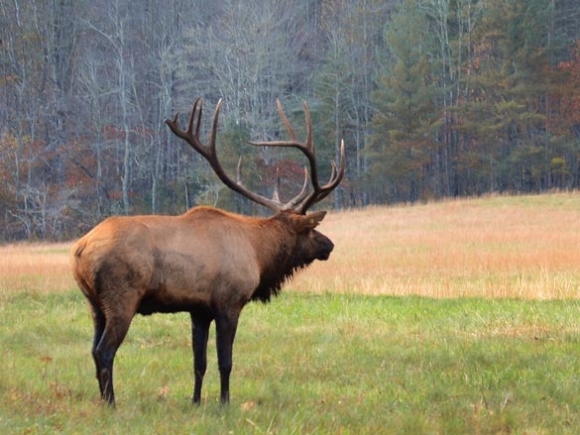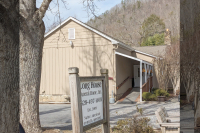Two elk found dead on Jonathan Creek dairy farm

A technician with the N.C. Wildlife Resources Commission was out for a routine check of an elk fence installed at the Ralph Ross and Sons Dairy Farm on Jan. 31 when he spotted two young bull elk dead on the property.
One elk was found inside the fence, which the Wildlife Commission installed last year in response to ongoing elk-human conflicts on the Ross property, while a second was found outside of the fence, according to the Wildlife Commission’s private lands coordinator Brad Howard. However, no photographs were taken of the scene, and when Lt. Andrew Helton returned the next day to investigate, the elk had been buried by Ronnie Ross, Ralph Ross’ nephew and the adjacent landowner. Meanwhile, Ralph Ross contends that there were no dead elk on his property, just on Ronnie Ross’.
“The landowner came back and dug the bulls back up and allowed us to look them over. There was no sign, that we could tell, that the bulls had been shot,” Helton said, adding that the landowners were cooperative.
According to Howard, the carcasses, though still relatively fresh, had deteriorated too much to allow for any sort of tissue samples — absent bullet holes, it was impossible to tell how the elk had died.
“At this point we’ll just continue to monitor the situation, and if we have something like this happen again, hopefully we can get to the carcass a little bit sooner,” Howard said.
This is not the first time that a dead elk has been discovered on the Ralph Ross and Sons Dairy Farm. The family was in the news last winter when seven elk were shot on the property. Ralph Ross had called the Wildlife Commission Jan. 29, 2016, to report three elk shot for eating the winter wheat crop. Two weeks later, officials found four more dead elk in the woods nearby.
Related Items
No charges were filed in last year’s elk shootings, as North Carolina law gives landowners the right to shoot wild animals caught in the act of destroying property. The Ross family had maintained that the animals that were shot had been damaging the crops.
The two elk found dead this January are the only elk known to have died of unnatural causes this year. Wildlife Commission staff euthanized a cow elk Jan. 18 that was suffering from the final stages of brainworm — a disease that only elk are susceptible to, caused by a parasite that a certain type of snail carries — and in the weeks following Thanksgiving a deer hunter accidentally shot a young bull elk in the Harmon Den area, a case of mistaken identity.
However, there is no proof that the two elk found on the Ross property last month died of unnatural causes.
“We don’t know what happened,” Howard said. “It was a weird situation, but I’ve been working with wildlife for 20-plus years and occasionally weird situations happen. We’re going to continue to try to work and keep the elk out of the places they don’t want them to be.”
Elk are native to the Southern Appalachians but disappeared for more than 200 years due to habitat loss and overhunting. They were reintroduced to the Great Smoky Mountains National Park in 2001 and have been growing in population ever since — now, their range extends well beyond park boundaries, with the original herd of 52 up to an estimated 150.
While some count that expansion a success, for others — particularly for area farmers — it’s caused problems. People who make their living from the land are now having to factor potential damage from a 700-pound animal into the already tenuous equation of the agricultural lifestyle. Likewise, Wildlife Commission staff is learning on the job how to balance wildlife conservation with the issues that this particular species can cause landowners.
One technique they’ve used is installing elk fences on properties where there have been conflicts, including the Ross farm. Following the seven elk deaths last year, the Ross family allowed the Wildlife Commission to install a 2-mile fence around the property, which cost $19,000 for labor and materials and was paid for using state money originating from hunting license sales. The Rocky Mountain Elk Foundation reimbursed the Wildlife Commission for $1,900.
According to Ralph Ross, the fence has helped but hasn’t been completely successful.
“It might have helped some, but they’ve been getting through it,” he said.
Howard said the Wildlife Commission got a call from the landowners in late January, not long before the dead elk were found, saying that elk were appearing inside the fenced areas. Some of them had figured out how to get through the fence, Howard said, and wild pigs were following suit. Meanwhile, at a nearby property owned by Steve Ross that had also received Wildlife Commission fencing, one side of the fence had lost electricity. Howard said that likely had to do with strong storms that came through the area last month. Upon hearing of the issues, Wildlife Commission staff put in some work to repair both fences, some of which is still ongoing.
“They’ve not been back lately,” Ralph Ross said of the elk, “but they will be back.”
Howard believes that the best hope for reducing elk-human conflicts going forward is to designate public lands managed for elk habitat so that elk will have less reason to munch on farmers’ crops. Some work has already been done to that end. This month, the Wildlife Commission approved creation of the 1,925-acre William H. Silver Game Land in the Maggie Valley area, a property comprised of various tracts that The Conservation Fund has been working for years to acquire for the Wildlife Commission’s elk management efforts.
“We’re slowly expanding opportunities to create a quality habitat for elk on public land,” Howard said. “That’s something that the private landowners and even the general public has wanted to see.”













